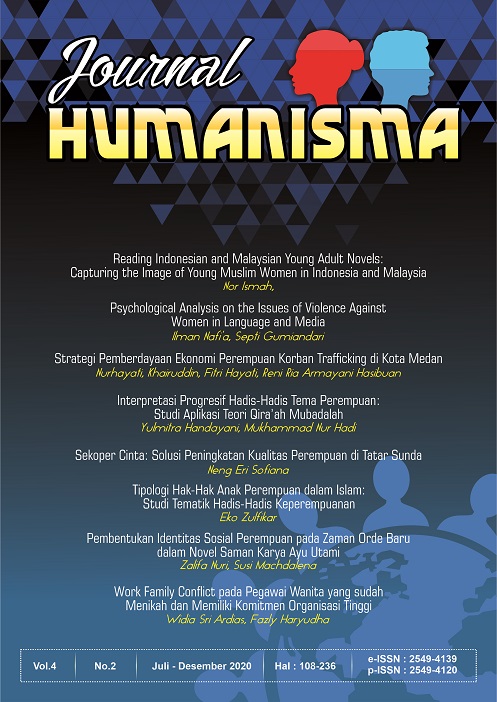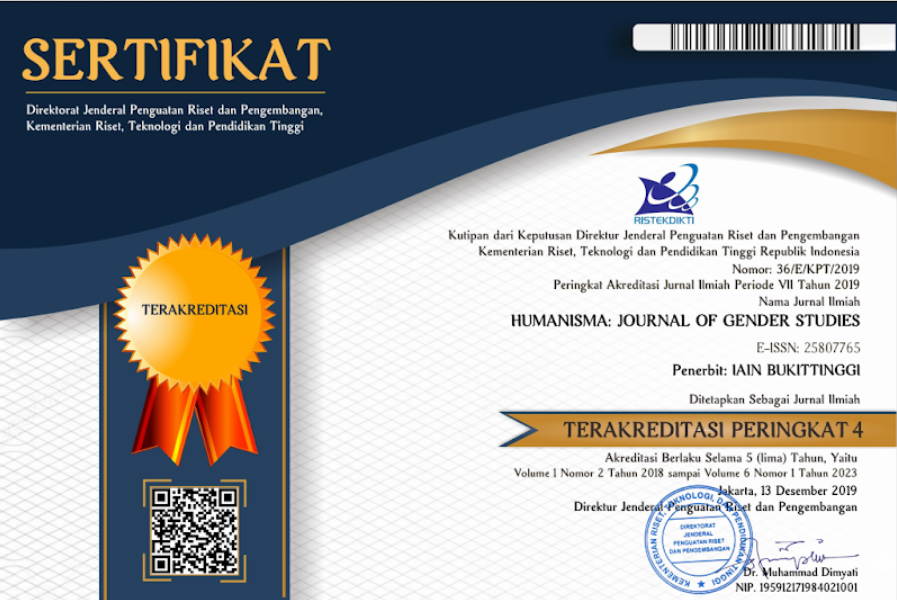Psychological Analysis on the Issues of Violence Against Women in Language and Media
DOI:
https://doi.org/10.30983/humanisme.v4i2.3179Keywords:
Abstract
Language and media are effective entities to perpetuate male domination over women. Both are representations of various social conflicts, interests, power and hegemony. Through Psychological analysis, this study aims to reveal how both of them can establish the process of 'marginalizing' women. This study used a qualitative method with a literature review approach. The results showed that violence against women in language and the media is an invisible form of violence. Language is something that has a purpose (teleology) in itself, which is conditioned by various environmental interests. In patriarchal culture, language is used to build a bad image of women with the aim of strengthening the position of men as the dominant group. The bad image is then transplanted by the media, made into a universe of discourse and implanted into collective consciousness as the public's subconscious imagination. As a result, whether we realize it or not, women are treated in a subordinate way, but also define themselves in a subordinate way according to men's eyes.
Â
Bahasa dan media adalah entitas yang efektif untuk mengekalkan dominasi laki-laki atas perempuan. Keduanya merupakan representasi dari pagelaran berbagai konflik sosial, kepentingan, kekuasaan serta hegemoni. Melalui analisis Psikologi, kajian ini bertujuan untuk mengungkapbagaimana keduanya dapat memapankan proses ‘memarjinalkan’ kaum perempuan. Kajian ini menggunakan metode kualitatif deskriptif dengan teknik pengambilan data sekunder melalui kajian literatur. Hasil penelitian menunjukan bahwa kekerasan terhadap perempuan dalam bahasa dan media adalah bentuk kekerasan yang tidak kasat mata. Bahasa merupakan ekspresi seseorang untuk mewakili logika, struktur budaya, sosial, psikologi, filosofi, dan politik yang dianut oleh penuturnya. Ia memiliki ketertujuan (teleologi) di dalam dirinya, yang terkondisi oleh pelbagai interes lingkungannya. Dalam budaya patriarkhi, Bahasa digunakan untuk membagun image buruk pada perempuan dengan tujuan mengukuhkan posisi laki-laki sebagai kelompok dominan. Image buruk tersebut kemudian dicangkok oleh media, dijadikan pemahaman universal, dan ditanamkan ke dalam kesadaran kolektif sebagai imajinasi alam bawah sadar masyarakat. Wal-hasil, disadari atau tidak, perempuan selain diperlakukan secara subordinatif, juga mendefinisikan diri secara subordinatif sesuai dengan perspektif laki-laki.
References
Abdillah, Junaidi. Radikalisme Agama: Dekonstruksi Tafsir Ayat-Ayat “Kekerasan†Dalam Al-Qur’an. Kalam: Jurnal Studi Agama dan Pemikiran Islam, Vol. 8, Isuue 2, December 2014, p. 281-300.
Abduh, Muhammad, (1367), Al-Manar, Kairo: Darul Manar, jilid. I, p. 21.
Abou el Fadl, Khaled M., (2004)., Atas Nama Tuhan: dari Fikih Otoriter ke Fikih Otoritatif, transated by R. Cecep Lukman Hakim. Jakarta: Serambi, p. 311.
Abu Zaid, Nasr Hamid, (2011), Women in the Discourse of Crisis, Cairo, Egypt: The Legal Research and Resource center for Human Right pages. (LRRC).
Andi, Nofri N, Analisis Terhadap Hadis-Hadis Pemberdayaan Perempuan, Humanisma: Journal of Gender Studies, Vol. 2, issue 2, Juli- Desember 2018, p. 159-166.
Atabik, Ahmad, Wajah Maskulin Tafsir al-Qur’an: studi intertekstualitas ayat-ayat kesetaraan Gender, Palastren: Jurnal Studi Gender, Vol. 6, Issue 2, December 2016, p. 299-322.
At-Thabari, (2000), Jami’ al-Bayan, Kairo: Maktabah al-Syamelah, p. 599.
Black, James, (1983), The War against Women, London: Penguin, h. 12.
Boonzaier, Floretta, The Life and death of Anene Booysen: Colonial discourse, gender-based violence and media representations, South African Journal of Psychology, Vol. 47, Issue 4, 2017, p. 470-481.
Brownmiller, Susan, (1975), Against Our Will, New York: Oxford University Press, h. 34.
Cott, Nancy F., Passionlessness: An interpretation of Victorian sexual ideology, 1790-1850, Signs: Journal of Women in Culture and Society, Vol. 4, Issue 2, 1978, p. 219-236.
Damean, Diana, Media and gender: Constructing feminine identities in a postmodern culture, Journal for the Study of Religions and Ideologies, Vol. 5, Issue 14, 2010, p. 89-94.
Davis, Philip M. and William H. Walters, The impact of Free Access to the Scientific Literature: A review of Recent Research, Journal of the Medical Library Association: JMLA, Vol. 99, Issue 3, July 2011, h. 208.
Eagleton, Terry, (2014), Ideology, Routledge, p. 123.
Easteal, Patricia, Kate Holland, and Keziah Judd, Enduring themes and silences in media portrayals of violence against women, Women's Studies International Forum, Vol. 48, Jan-Feb 2014, p. 103-113.
Elund, Jude, Masculinity, mass consumerism and subversive sex: A case study of Second Life’s ‘Zeus’ gay club. Sexualities, Vol. 16, Issue 3-4, 2013, p. 423-444.
Eriyanti, Linda Dewi, Pemikiran Johan Galtung tentang Kekerasan dalam Perspektif Feminisme, Jurnal Hubungan Internasional, Vol 6, Issue 1, September 2017, p. 27-37.
Forum Kajian Kitab Kuning, (2001), Wajah Baru Relasi Suami-Istri, Yogyakarta: LKiS, p. 94.
Foucault, (1972), The Archeology of Knowledge and The Discourse on Language, New York: Pantheon Books, h. 24.
Gadamer, Hans George, (1977), Philosophical Hermeneutics, London: University of Californis press, h. 27.
Gumiandari, Septi & Ilman Nafi'a, Women in The Identity Crisis of Feminism; A Critical Analysis on Gender Movement Based on Islamic Psychology Perspective, Humanisma: Journal of Gender Studies, Vol. 3, Issue 1, January-June 2019, p. 1-12
Hald, Gert Martin, Neil M. Malamuth, and Carlin Yuen, Pornography and attitudes supporting violence against women: Revisiting the relationship in nonexperimental studies, Aggressive Behavior: Official Journal of the International Society for Research on Aggression, Vol. 36, Issue 1, 2010, p. 14-20.
Harrigan, Jinni A., and Karen S. Lucic, Attitudes about gender bias in language: A reevaluation, Sex Roles 19. Vol. 3, Issue 4, 1988, p. 129-140.
Hikam, Muhammad AS., (1996), "Bahasa dan Politik; Penghampiran “Discursive Practice" in Yudi Latif and Idi Subandy. Bahasa dan Kekuasaan; Politik Wacana di Panggung Orde Baru. Bandung: Mizan, h. 77.
Ibnu Haldun, (2011), Muqaddimah, Beirut: Darul Fikir, p. 438.
Jiwani, Yasmin, Symbolic and discursive violence in media representations of Aboriginal missing and murdered women, Understanding violence: Contexts and portrayals (2009): 63-74.
Johansson, Thomas, and Nils Hammarén, Hegemonic masculinity and pornography: Young people's attitudes toward and relations to pornography, The Journal of Men’s Studies, Vol. 15, Issue 1, 2007, p. 57-70.
Johnson, Barbara, The Frame of Reference: Poe, Lacan, Derrida, Yale French Studies, Vol. 55, Issue. 56, July 1977, h. 457-505.
Krippendorff, Klaus, (1981), Content Analysis; Introduction to Its Theory and Methodology, Translated by Farid Wajidi, Jakarta: Rajawali Press, h. 15.
Lisnawati, Lis, Psikolinguistik dalam Pembelajaran Bahasa, Educare, Vol. 6, No. 1, Agustus 2008, h. 31-43.
Menegatti, Michela and Monica Rubini, Gender bias and sexism in language, Oxford Research Encyclopedia of Communication, September 2017, p.1-24.
Mubaligh, Ahmad, Relasi bahasa dan ideology, Lingua: Jurnal Ilmu Bahasa Dan Sastra, Vol. 5, Issue 2, Descmber 2010, h. 112-118.
Muhammad bin Iyas, (1982), Bada'i al-Zuhur fi Waqai' al-Duhur, Beirut: Maktabah Saqafiyyah, p. 52.
Muhammad, Husein, (2001), Fiqh Perempuan; Refleksi Kiai atas Wacana Agama dan Gender, Yogya: LKiS Pelangi Aksara, p. 180-183.
Ng, S. H., Language-based discrimination: Blatant and subtle forms, Journal of Language and Social Psychology, Vol. 26, 2007, p. 106–122.
Nur Hasnah, Bias Gender Dalam Buku Ajar Al-Arabiyah Linnaasyiin, Humanisma: Journal of Gender Studies, Vol. 1, Issue 1, January- June 2017, p. 61-74
Nursyahbani, (2001), Aspek hukum kekerasan terhadap perempuan, Madura: STAIN Pamekasan Press.
Park, Ji Ho, Jamin Shin, and Pascale Fun, Reducing gender bias in abusive language detection, arXiv preprint arXiv:1808.07231 August 2018, p. 1-6.
Poerwadarmita, (1980), Kamus Umum Bahasa Indonesia, Bandung: Penerbit Hasta, h. 79.
Pool, Jonathan, (1990), Language regimes and political regimes In Language policy and political development, Ablex Publishing, h. 241-261.
Putri, Reza Riana, (2012), Kekerasan dalam berpacaran. Dissertation of Universitas Muhammadiyah Surakarta University.
Rahardjo, Mudjia, Kekerasan Terhadap Perempuan Dalam Bahasa dan Media, El-Harakah; Jurnal Budaya dan Islam, Vo. 3, Issue 1, Jan-March 2018, p. 1-8.
Rodgerson, Gillian, and Elizabeth Wilson, (1993), Pornography and Feminism; the case against consorship, in Stevi Jackson, New York University Press, p. 288.
Rodin, Dede, Islam dan Radikalisme: Telaah atas Ayat-ayat Kekerasan dalam al-Qur’an, Addin, Vol 10, Issue 1, February 2016, p. 29-60.
Said, Mas’ud, (2000), Clinton, Wanita dan terpaan Media, Jawa Pos, Kamis, 23 Juli 2000.
Santaemilia, José, and Sergio Maruenda, The linguistic representation of gender violence in (written) media discourse: The term ‘woman’ in Spanish contemporary newspapers, Journal of Language Aggression and Conflict, Vol. 2, Issue 2, January 2014, p. 249-273.
Sczesny, S., Formanowicz, M., & Moser, M., Can gender-fair language reduce gender stereotyping & discrimination?, Frontiers in Psychology, Vol. 7, Issue, 25, 2016, 3-8.
Shodiq, Muhammad Jafar. Bias Gender dalam Buku Bahasa Arab Siswa MA Kelas X dengan Pendekatan Saintifik 2013. Jurnal Pendidikan Islam, Vol. 3, Issue 2, December 2014, p. 307-326.
Sobari, Teri, Kekerasan Simbolik dalam Bahasa Lirik Lagu, Penelitian-Pendikan, Vol. 10, Issue 1, May 2011, p. 144.
Sofiani, Triana, Tafsir Agama Dan Kekerasan Berbasis Gender, Jurnal Penelitian, Vol. 5, Issue 2, November 2013, p. 1-14.
Sugiyono, (2010), Metode penelitian kuantitatif, kualitatif & RND. Bandung: Alfabeta.
Supadiyanto, Pornography In Print Media: Legal Review Of Pornografic Content On Mantra Tabloid In Indonesia, Journal of Social Studies, Vol. 15, Issue 1, 2019, p. 46-62.
Suseno, Frans Magnis, (2000), Pengantar melawan kekerasan tanpa kekerasan, Yogyakarta: Pustaka pelajar, p. 56.
Tranchese, Alessia, and Sole Alba Zollo. The Construction of Gender-based Violence in the British Printed and Broadcast Media, Critical Approaches to Discourse Analysis Across Disciplines, Vol 7, Issue 1, 2013, p.141 – 163.
Watts, Mark D., Elite cues and Media bias in Presidential Campaigns; explaining public perceptions of a liberal press, New York: Communication Research Journal, Sage Publication, Inc, Vol. 26, issue 2, April 1999, p. 144-175.
Weedon, Chris, (ed.) (1997), Post-War Woman's Writing in German: Feminist Critical Approaches, Berghahn Books, p. 965.
Wekke, Ismail Suardi, Gender dalam Materi Belajar Bahasa Arab di Pesantren, Turast: Jurnal Penelitian dan Pengabdian, Vol. 1, Issue 1, 2013, p. 55-56.
Downloads
Submitted
Accepted
Published
Issue
Section
License
Authors who publish with this journal agree to the following terms:
- Authors retain copyright and grant the journal right of first publication with the work simultaneously licensed under a Creative Commons Attribution-ShareAlike 4.0. that allows others to share the work with an acknowledgment of the work's authorship and initial publication in this journal.
- Authors are able to enter into separate, additional contractual arrangements for the non-exclusive distribution of the journal's published version of the work (e.g., post it to an institutional repository or publish it in a book), with an acknowledgment of its initial publication in this journal.
- Authors are permitted and encouraged to post their work online (e.g., in institutional repositories or on their website) prior to and during the submission process, as it can lead to productive exchanges, as well as earlier and greater citation of published work (See The Effect of Open Access).







